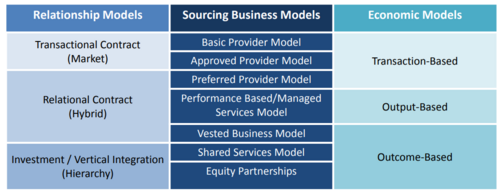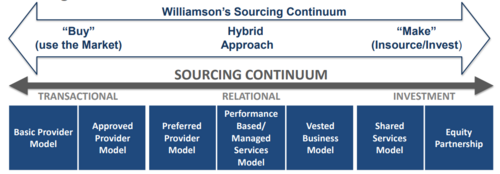Performance-based contracting
(→KPI) |
(→The Seven Sourcing Business Models) |
||
| Line 31: | Line 31: | ||
Performance-based contracting is a part of the so-called Seven Sourcing Business Models which are fundamental supply business models that are established with the supplier to support the purchase requirements. The models are useful within procurement management and can be used to create value and manage risk in various different ways. | Performance-based contracting is a part of the so-called Seven Sourcing Business Models which are fundamental supply business models that are established with the supplier to support the purchase requirements. The models are useful within procurement management and can be used to create value and manage risk in various different ways. | ||
| − | A fundamental question a company or organisation needs to ask itself is how to obtain the goods and services required to run the business. On the one hand it they can be "bought" on the marked externally or on the other hand they can be "made" via insourcing internally in the company. A hybrid approach also exists in between the two extremes. This is illustrated in Figure | + | A fundamental question a company or organisation needs to ask itself is how to obtain the goods and services required to run the business. On the one hand it they can be "bought" on the marked externally or on the other hand they can be "made" via insourcing internally in the company. A hybrid approach also exists in between the two extremes. This is illustrated in Figure 2. |
| − | [[File:Wiki_test.PNG|500px|thumb|right| | + | [[File:Wiki_test.PNG|500px|thumb|right|Figure 2]] |
Depending on the sourcing situation a given organisation or company is in, the most appropriate Sourcing Business Model should be chosen in order to optimize for the business environment the organisation or company is navigating. | Depending on the sourcing situation a given organisation or company is in, the most appropriate Sourcing Business Model should be chosen in order to optimize for the business environment the organisation or company is navigating. | ||
| − | As seen in Figure | + | As seen in Figure 2 the Sourcing Business Models include:<ref name="SSBM">https://www.sig.org/docs2/WS05_Seven_Sourcing_Business_Models_ForeFront_Group_2016_04_16 </ref> |
*Basic Transaction Provider | *Basic Transaction Provider | ||
*Approved Provider | *Approved Provider | ||
| Line 83: | Line 83: | ||
*'''Shared Services''' | *'''Shared Services''' | ||
| + | A Shared Services model is an investment-based model which aims to setup an internal functional business unit which is able to provide goods or services to the rest of the broader organization. It is essentially an organisation which outsources to its own internal supplier while other business units and users in the organisation are charged for the services the "outsourced" units provide. | ||
*'''Equity Partnerships''' | *'''Equity Partnerships''' | ||
Revision as of 18:57, 22 February 2019
Abstract
In this article a review of performance-based contracting will be presented. Performance-based contracting (PBC) is a product support strategy in which the procurement model is based on clearly defined objectives and key performance indicators (KPIs) [1]. These are the driving forces to encourage behaviours that achieve the required project objectives and procurement. Specific KPIs such as cost, quality and completion are the basis of project consequences, in the form of risk and reward, for the involved contract participants. The concept of KPIs will also be studied in this article along with a brief description of what a contract is in general. In performance-based contracting the incentivized performance measures serve the purpose of motivating the supplier to improve performance and cost effectiveness through enhanced internal practices. This is different than the more traditionally used transaction-based contracting, also known as waterfall approach, in which payments are made based on completion of agreed milestones and project deliverables. Roughly speaking the key difference between the two methods lies in the fact that performance-based contracting describes the work in terms of the required results rather than "how" the work should be accomplished [2]. The concept of Sourcing Business Models as well as The Seven Sourcing Business Models will be explained and it will be elaborated how PBC fits into this theory.
Contents |
Contract
In order to provide some background to the idea of performance-based contracting it can be useful to first get a sense of what a contract itself is. A contract can be described as a promise made between two or more persons or organisations in which each participating party agrees to do certain things.[3] The contract is a written list which describes the agreed upon items and it is therefore useful because it can be used to:
- State what is expected of the agreeing persons or organisations
- Protect the needs and rights of the agreeing parties
- Ensure encountability of the promises made by the agreeing parties
- State the consequences if the promises made are not fulfilled
Sourcing Business Models
Sourcing Business Models are used for procurement management for achieving the best fit between suppliers and buyers.
A Sourcing Business Model is based on the company's Relationship Model and it's Economic Model. The Relationship Model describes how the company wishes to influence or formally control the supply source. As seen in Figure 1 these can be described as being either transactional, relational or investment.
The Economic Model describes how the economics of the relationship should be managed. As seen from Figure 1 the Economic Models can either be:
- Transaction-based
- Activities are basis of payment(payment per hour, unit, activity)
- Output-based
- Payment is made for supplier output
- Outcome-based
- Business outcomes in which the reward (and risk) is shared
The Seven Sourcing Business Models
Performance-based contracting is a part of the so-called Seven Sourcing Business Models which are fundamental supply business models that are established with the supplier to support the purchase requirements. The models are useful within procurement management and can be used to create value and manage risk in various different ways.
A fundamental question a company or organisation needs to ask itself is how to obtain the goods and services required to run the business. On the one hand it they can be "bought" on the marked externally or on the other hand they can be "made" via insourcing internally in the company. A hybrid approach also exists in between the two extremes. This is illustrated in Figure 2.
Depending on the sourcing situation a given organisation or company is in, the most appropriate Sourcing Business Model should be chosen in order to optimize for the business environment the organisation or company is navigating.
As seen in Figure 2 the Sourcing Business Models include:[4]
- Basic Transaction Provider
- Approved Provider
- Preferred Provider
- Performance-Based Agreement
- Vested Business Model
- Shared Services
- Equity Partnerships
These models fall within the so-called sourcing continuum which can be described as being either transactional, relational or investment.
A more detailed description of each model is provided in the following sections:
- Basic Transaction Provider
The primary purpose of this model is to acquire goods or services at the lowest cost posible. The supplier provides a basic transaction and thus operates under a simple buy-sell arrangement. The buyer pays a fixed transaction price for the goods or services provided. The Economic model is transaction-based while the Relationship model is transactional.
- Approved Provider
This model assumes using few proven suppliers. The proven suppliers live up to predefined qualification characteristics or other criteria or have previously performed well. Trusting few suppliers means that larger volumes of goods or services can be used as leverage to gain pricing discounts or reduction of other expences such as administrative costs.
- Preferred Provider
The suppliers are here chosen specifically and exclusive arrangements may exist allowing for more streamlined buying processes and easily repeatable business. The main purpose with this model is to achieve best value or volume discounts via longer-term contracts. The Economic Model is transaction-based and the Relationship-model is relational.
- Performance-Based Agreement/Contracting
The primary purpose of the Performance-Based Agreement is to ensure high efficiency and service levels by utilizing expert providers as suppliers. It is intended to achieve these service levels by use of longer-term contracts to make sure that the supplier invests in product improvements and cost savings. The aim is to buy performance rather than transactional goods or services. The method is also known as "painshare/gainshare", "pay for performance" or "managed service agreement with fixed fee" and it essentially shifts the risk to the supplier. The Economic model is transaction-based with output performance incentives and penalties. The implementation of the Performance-Based Contracting is typically carried out in eight steps:[5]
1) Business Case: A business case which assesses the benefits, risks and other impacts of the contract is presented to senior staff as input for decision making.
2) Outcomes: The desired deliverable or result of the contract in presented.
3) Measures: A set of performance measures is defined in order to measure the performance compared to the defined outcomes.
4) Levels: Performance levels are used to determine how well the contractor needs to perform in terms of the defined performance measures.
5) Payment: It is defined how much the contractor should be payed for a given performance level.
6) Incentives: A group of incentives is defined in order to encourage positive behaviour and punish negative behaviour.
7) Contract: A contract which covers all aspects of the performance, terms and conditions and payment of the relationship is drafted, reviewed and finalised.
8) Review: With the differing definitions of succes in mind of the groups involved with the contract, an analysis of the outcomes of the PBC is carried out.
- Vested Business Model
This model aims to generate and optimize value through a co-managed and co-developed collaboration with an external expert. This developed value would not otherwise have been achieved through individual work. The idea is to create a win-win collaboration where the buyer and supplier are equally committed to ensure succes for each other. Longer-term relationships between 5 to 15 years are typically created and often lead to solutions that expand the boundaries of businesses. The model is good for risk managing and the Economic model is outcome-based while the Relationship model is relational.
- Shared Services
A Shared Services model is an investment-based model which aims to setup an internal functional business unit which is able to provide goods or services to the rest of the broader organization. It is essentially an organisation which outsources to its own internal supplier while other business units and users in the organisation are charged for the services the "outsourced" units provide.
- Equity Partnerships
References
- ↑ http://www.pitcher.com.au/news/performance-based-contracts-kpis-drive-performance-and-strategic-outcomes.
- ↑ https://www.nigp.org/docs/default-source/New-Site/global-best-practices/performancebased.pdf?sfvrsn=2.
- ↑ https://www.artslaw.com.au/legal/raw-law/what-is-a-contract
- ↑ https://www.sig.org/docs2/WS05_Seven_Sourcing_Business_Models_ForeFront_Group_2016_04_16
- ↑ https://en.wikipedia.org/wiki/Performance-based_contracting#cite_note-7

